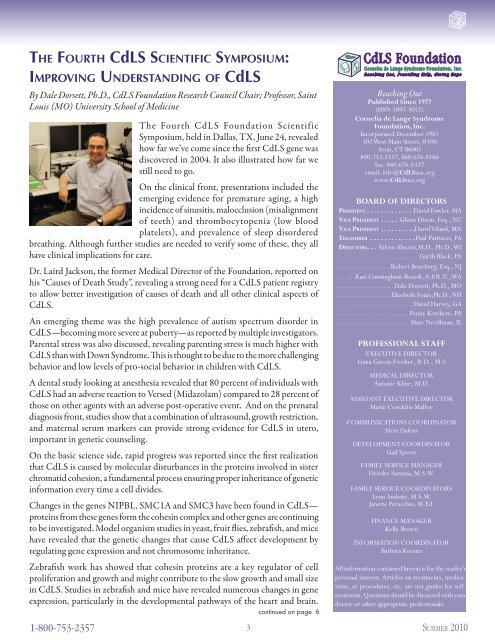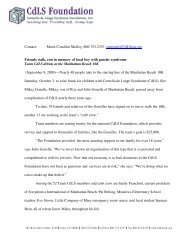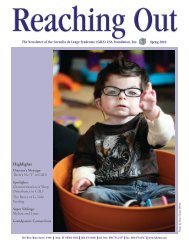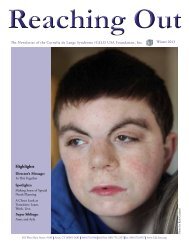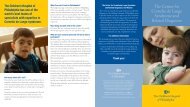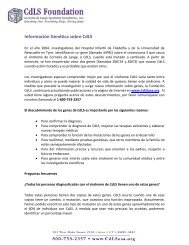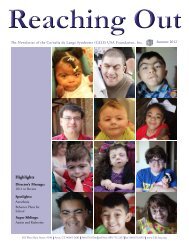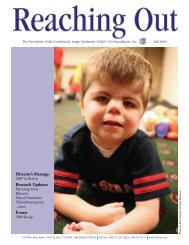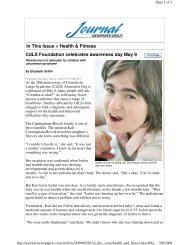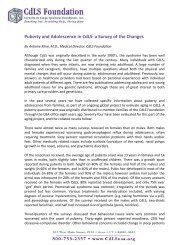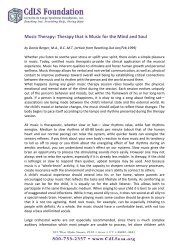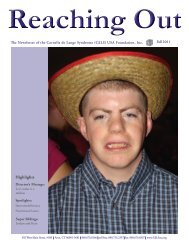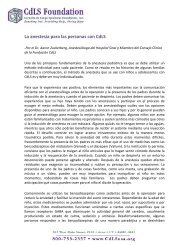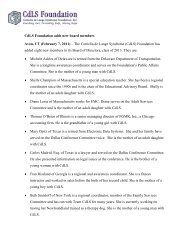Summer 2010 - CdLS
Summer 2010 - CdLS
Summer 2010 - CdLS
You also want an ePaper? Increase the reach of your titles
YUMPU automatically turns print PDFs into web optimized ePapers that Google loves.
Th e Fo u r t h <strong>CdLS</strong> Scientific Sy m p o s i um :Im p r o v i n g Un d e r s ta n d i n g o f <strong>CdLS</strong>By Dale Dorsett, Ph.D., <strong>CdLS</strong> Foundation Research Council Chair; Professor, SaintLouis (MO) University School of MedicineThe Fourth <strong>CdLS</strong> Foundation ScientificSymposium, held in Dallas, TX, June 24, revealedhow far we’ve come since the first <strong>CdLS</strong> gene wasdiscovered in 2004. It also illustrated how far westill need to go.On the clinical front, presentations included theemerging evidence for premature aging, a highincidence of sinusitis, malocclusion (misalignmentof teeth) and thrombocytopenia (low bloodplatelets), and prevalence of sleep disorderedbreathing. Although further studies are needed to verify some of these, they allhave clinical implications for care.Dr. Laird Jackson, the former Medical Director of the Foundation, reported onhis “Causes of Death Study”, revealing a strong need for a <strong>CdLS</strong> patient registryto allow better investigation of causes of death and all other clinical aspects of<strong>CdLS</strong>.An emerging theme was the high prevalence of autism spectrum disorder in<strong>CdLS</strong>—becoming more severe at puberty—as reported by multiple investigators.Parental stress was also discussed, revealing parenting stress is much higher with<strong>CdLS</strong> than with Down Syndrome. This is thought to be due to the more challengingbehavior and low levels of pro-social behavior in children with <strong>CdLS</strong>.A dental study looking at anesthesia revealed that 80 percent of individuals with<strong>CdLS</strong> had an adverse reaction to Versed (Midazolam) compared to 28 percent ofthose on other agents with an adverse post-operative event. And on the prenataldiagnosis front, studies show that a combination of ultrasound, growth restriction,and maternal serum markers can provide strong evidence for <strong>CdLS</strong> in utero,important in genetic counseling.On the basic science side, rapid progress was reported since the first realizationthat <strong>CdLS</strong> is caused by molecular disturbances in the proteins involved in sisterchromatid cohesion, a fundamental process ensuring proper inheritance of geneticinformation every time a cell divides.Changes in the genes NIPBL, SMC1A and SMC3 have been found in <strong>CdLS</strong>—proteins from these genes form the cohesin complex and other genes are continuingto be investigated. Model organism studies in yeast, fruit flies, zebrafish, and micehave revealed that the genetic changes that cause <strong>CdLS</strong> affect development byregulating gene expression and not chromosome inheritance.Zebrafish work has showed that cohesin proteins are a key regulator of cellproliferation and growth and might contribute to the slow growth and small sizein <strong>CdLS</strong>. Studies in zebrafish and mice have revealed numerous changes in geneexpression, particularly in the developmental pathways of the heart and brain.1-800-753-2357continued on page 6<strong>CdLS</strong> FoundationCornelia de Lange Syndrome Foundation, Inc.Reaching Out, Providing Help, Giving HopeReaching OutPublished Since 1977(ISSN 1097-3052)Cornelia de Lange SyndromeFoundation, Inc.Incorporated December 1981302 West Main Street, #100Avon, CT 06001800.753.2357, 860.676.8166fax: 860.676.8337email: info@<strong>CdLS</strong>usa.orgwww.<strong>CdLS</strong>usa.orgBoard of DirectorsPresident.. . . . . . . . . . . . . David Fowler, MAVi c e President .. . . . . Glenn Dixon, Esq., NCVi c e President .. . . . . . . . . David Viland, MNTr e a s u r e r .. . . . . . . . . . . . Paul Patitucci, PADi r e c t o r s. . . Eileen Ahearn,M.D., Ph.D., WI. . . . . . . . . . . . . . . . . . . . . Garth Black, PA. . . . . . . . . . . . . . Robert Boneberg, Esq., NJ. . . . Kari Cunningham-Rosvik, A.P.R.N., WA. . . . . . . . . . . . . . .Dale Dorsett, Ph.D., MO. . . . . . . . . . . . . . Elizabeth Fouts,Ph.D., NH. . . . . . . . . . . . . . . . . . . . David Harvey, GA. . . . . . . . . . . . . . . . . . . Penny Ketchem, PA. . . . . . . . . . . . . . . . . . . Marc Needlman, ILPROFESSIONAL STAFFEXECUTIVE DIRECTORLiana Garcia-Fresher, R.D., M.SMEDICAL DIRECTORAntonie Kline, M.D.ASSISTANT EXECUTIVE DIRECTORMarie Concklin-MalloyCOMMUNICATIONS COORDINATORAlexi DaleneDEVELOPMENT COORDINATORGail SpeersFAMILY SERVICE MANAGERDeirdre Summa, M.S.W.FAMILY SERVICE COORDINATORSLynn Audette, M.S.W.Janette Peracchio, M.Ed.FINANCE MANAGERKelly BrownINFORMATION COORDINATORBarbara KoontzAll information contained herein is for the reader’spersonal interest. Articles on treatments, medications,or procedures, etc. are not guides for selftreatment.Questions should be discussed with yourdoctor or other appropriate professionals.3 Su m m e r <strong>2010</strong>


